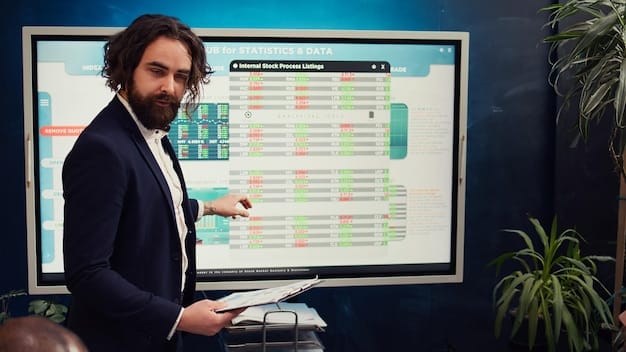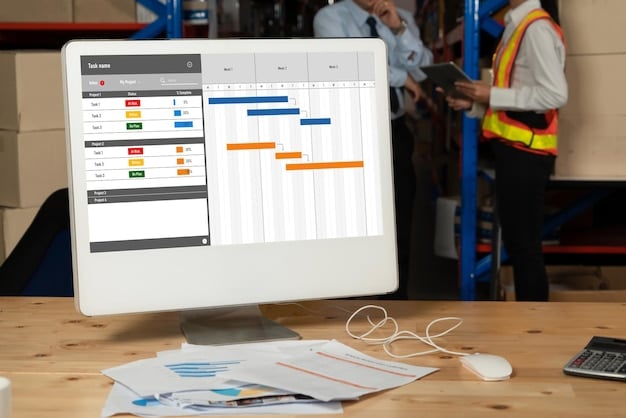Task Dependencies: US Project Timelines Improvement Guide (2025)

Task dependencies are crucial for optimizing project timelines in the US in 2025, enabling project managers to streamline workflows, avoid bottlenecks, and ensure timely project completion by understanding and strategically implementing these dependencies.
Are you looking to enhance your project management skills and meet deadlines more effectively in the US in 2025? Understanding and leveraging task dependencies is key to improving project timelines and ensuring successful project outcomes. Keep reading to learn more!
Understanding Task Dependencies in 2025
In project management, a task dependency exists when the start or finish of one task relies on the start or finish of another. Recognizing and managing these dependencies is essential for creating realistic project schedules and optimizing resource allocation.
Effective management of task dependencies ensures projects run smoothly, minimizing delays and maximizing efficiency. Let’s explore this concept further.
Types of Task Dependencies
Task dependencies are not one-size-fits-all. They come in various forms, each requiring a different approach to management. Here are the primary types:
- Finish-to-Start (FS): The successor task cannot start until the predecessor task is completed.
- Start-to-Start (SS): The successor task cannot start until the predecessor task starts.
- Finish-to-Finish (FF): The successor task cannot finish until the predecessor task finishes.
- Start-to-Finish (SF): The successor task cannot finish until the predecessor task starts (rarely used).
These dependencies create a sequence that dictates the order tasks must be completed, contributing significantly to project timelines.
Understanding these dependency types helps project managers build accurate project plans and allocate resources effectively.

Why Task Dependencies Matter for US Project Timelines in 2025
Task dependencies play a crucial role in shaping project timelines. Ignoring them can lead to unrealistic schedules, resource conflicts, and missed deadlines. Here’s why they matter, especially in the context of the dynamic US business environment in 2025:
Properly managing task dependencies ensures that projects are more likely to be completed on time and within budget.
Improved Accuracy in Scheduling
By identifying and mapping out task dependencies, project managers can create more realistic and accurate project schedules. When tasks are sequentially linked, the impact of delays becomes immediately apparent.
This allows for proactive adjustments such as resource reallocation or scope renegotiation to mitigate potential timeline disruptions.
Efficient Resource Allocation
Understanding task dependencies helps in optimally allocating resources. Resources can be assigned more effectively when task sequences are clear, preventing bottlenecks and ensuring that resources are available when and where they are needed.
This leads to better resource utilization, reducing waste and improving overall project efficiency.
Better visibility into task relationships can minimize resource conflicts, ensuring that the right resources are available at the correct times.
Implementing Task Dependencies: Best Practices for 2025
Implementing task dependencies effectively requires a systematic approach. Here are some best practices to consider in the US project management landscape in 2025:
Applying these practices can improve the accuracy and efficiency of project schedules, leading to better project outcomes.
- Identify and Document: Begin by identifying all tasks and their dependencies, documenting them clearly in a project management tool or spreadsheet.
- Use Project Management Software: Leverage project management software that supports dependency mapping, such as Asana, Jira, or Microsoft Project.
- Communicate Clearly: Ensure all team members understand the dependencies and their roles in the project workflow.
- Regular Monitoring: Continuously monitor task progress and adjust dependencies as needed to maintain the project timeline.
Regular reassessment of dependencies helps to maintain accuracy and relevance as the project evolves.
By adhering to these steps, project managers can implement task dependencies effectively and improve project timelines.
Tools and Technologies for Managing Task Dependencies in 2025
Several tools and technologies are available to assist in managing task dependencies. Selecting the right tools can significantly improve project management efficiency and accuracy. Here are some options:
Integrating these tools into your project management workflow can lead to significant improvements in project delivery.

Project Management Software
Asana, Jira, and Microsoft Project are leading project management tools that offer robust features for dependency management. These platforms allow project managers to map dependencies, set milestones, and track progress in real-time.
These tools also facilitate collaboration among team members, ensuring everyone is aware of the project’s critical path and their individual responsibilities.
Utilizing these platforms can enhance team collaboration and project transparency, leading to better outcomes.
Gantt Charts
Gantt charts are visual tools that display project timelines, tasks, and dependencies. They help project managers understand the sequence of tasks and identify potential bottlenecks.
Gantt charts provide a clear overview of project timelines, making it easier to monitor progress and make necessary adjustments.
Gantt charts support proactive project management, enabling quick responses to potential problems and improving overall project flow
Common Pitfalls to Avoid When Managing Task Dependencies
Even with the right tools and processes, several pitfalls can undermine the effective management of task dependencies. Avoiding these mistakes is crucial for maintaining accurate project timelines.
Being aware of these common issues can help you proactively prevent them, improving your project outcomes.
Ignoring Dependencies
One of the most common mistakes is simply overlooking existing task dependencies. This can lead to unrealistic schedules and resource conflicts.
Taking the time to thoroughly analyze and document all task relationships is critical for creating an accurate project plan.
- Incomplete Analysis: Not identifying all dependencies during the planning phase.
- Poor Communication: Failing to communicate dependencies to team members.
- Lack of Visibility: Not using tools that provide clear visibility into task relationships.
Identifying and actively managing dependencies is essential for project success.
Overcomplicating Dependencies
Overly complex dependency structures can lead to confusion and difficulties in managing the project. Keep the relationships as simple and clear as possible.
Regularly reviewing and simplifying the dependency structure can make the project more manageable and improve overall efficiency.
Striving for simplicity ensures everyone can understand the project’s critical path, thus reducing the risk of errors and delays.
The Future of Task Dependency Management in the US (2025 and Beyond)
As technology continues to evolve, the future of task dependency management in the US looks promising. Here are some trends to watch for in 2025 and beyond:
Adopting these trends can help project managers stay ahead of the curve and deliver increasingly efficient and successful projects.
AI and Machine Learning
Artificial intelligence and machine learning offer the potential to automate task dependency management. These technologies can analyze historical project data to identify patterns and predict potential dependencies.
AI-driven tools can also optimize task sequences and resource allocation, improving project timelines and reducing the risk of delays.
The integration of AI holds the promise of dramatically enhancing project management efficiency and accuracy.
Improved Collaboration Tools
Enhanced collaboration tools will make it easier for team members to communicate and coordinate their work on interdependent tasks. Real-time updates and shared dashboards can provide everyone with a clear view of the project’s progress.
Better communication can minimize misunderstandings and ensure dependencies are properly managed.
Enhanced real-time data and communication ensures all stakeholders understand the project’s status.
| Key Aspect | Brief Description |
|---|---|
| 🚀 Dependency Types | Understanding Finish-to-Start, Start-to-Start, Finish-to-Finish, and Start-to-Finish. |
| 🛠️ Resource Allocation | Efficient assignment based on task sequences to minimize bottlenecks. |
| 📊 Accurate Schedules | Improved timeline prediction and risk management. |
| 🤖 AI Integration | The adoption of AI to automate and predict dependencies. |
Frequently Asked Questions
▼
Task dependencies are relationships between tasks where the start or finish of one task is dependent on the start or finish of another. They dictate the order in which tasks must be performed.
▼
Task dependencies are vital for creating realistic project schedules, allocating resources efficiently, and minimizing delays. They ensure that tasks are performed in the correct order.
▼
The main types are Finish-to-Start (FS), Start-to-Start (SS), Finish-to-Finish (FF), and Start-to-Finish (SF). Each type defines a different relationship between dependent tasks.
▼
Project management software allows for the visual mapping of dependencies, real-time tracking of task progress, and adjustment of schedules as needed. Popular tools include Asana, Jira and Microsoft Project.
▼
Common mistakes include ignoring dependencies, overcomplicating dependency structures, and failing to monitor them regularly. Proper planning and communication help avoid these issues.
Conclusion
Mastering task dependencies is essential for improving project timelines in the US in 2025. By understanding the different types of dependencies, implementing best practices, and leveraging the right tools, project managers can optimize their project schedules, allocate resources efficiently, and ensure timely project completion. Embracing these strategies will lead to more successful projects and better business outcomes.





